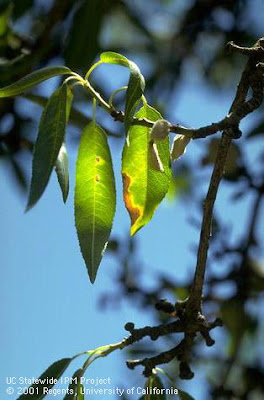Anthracnose (Colletotrichum gloeosporioides) is a damaging fungal disease that attacks the blossoms, leaves, fruit, and limbs of an almond tree. Infected leaves tend to develop water-soaked lesions that eventually fade in color (Figure 1). Defoliation can occur, but leaves often remain attached to the branches. Infected nuts often have a crater-like lesion in which the affected area turns a reddish orange(Figure 2). Often, the fruit may gum profusely as the fungus is able to penetrate into the kernel, killing the embryo. Affected nuts often remained attached to the spur(Figure 3). Shoots and spurs that bear infected nuts often become infected and die(Figure 4). Lack of culturing the fungus from these branches suggests that the wood does not die by direct fungal colonization, but by a produced toxin. Thus, this disease affects the current year’s crop as well as affecting the future crop by damaging and weakening the affected scaffolds. Figure 1: Almond leaves infected by Anthracnose.
Figure 1: Almond leaves infected by Anthracnose.
 Figure 2: Anthracnose infection of an almond. Note the profuse gumming coming from the kernal.
Figure 2: Anthracnose infection of an almond. Note the profuse gumming coming from the kernal.
Anthracnose is most severe in wet, warm springs (> 60F). Orchards that have a history of anthracnose should be treated during bloom (pink tip forward) to help protect blossoms. Repeated fungicide applications may be necessary through the spring as trees should be protected before rain events. Fungicides provide protection for up to 7-10 days, and rain events occurring beyond this “control window” may require another spray. All varieties are susceptible to Anthracnose, but they vary in their degree of susceptibility. Butte, Thompson, Merced, Price, Peerless, Winters, Monterey and Fritz are the most susceptible varieties. Harvey, Carmel, Ne Plus Ultra, Padre and Mission are moderately susceptible, with Nonpareil being the least susceptible.  Figure 3: Kernals killed by anthracnose often remain on the tree as dried, shriveled mummies.
Figure 3: Kernals killed by anthracnose often remain on the tree as dried, shriveled mummies.
 Figure 4: Anthracnose infection of almond branches.
Figure 4: Anthracnose infection of almond branches.
There are several fungicides that provide excellent control of anthracnose. These include the fungicide classes of Strobilurin/Boscalid (i.e. Pristine), DMI’s (Orbit, Quash, Indar, Inspire, etc.), strobilurins (i.e.Abound), and products that combine two different modes of action (Distinguish, Inspire, etc.). It is important to note that each class of fungicides should not be used in succession as rotating will help reduce the chance of resistance. If 3 or more fungicide applications are needed due to spring rains, a broad spectrum fungicide (Captan, Maneb, Chlorothalonil, or Ziram) should be rotated in to help provide control and decrease the chance of resistance. Please check the label to ensure an adequate post harvest interval.
Anthracnose has not been a problem over the past few years. This is probably due to the lack of winter and spring rains as well as the number of fungicides active on anthracnose. Often, fungicides applied for brown rot or scab control provide anthracnose control as well. Forecasted wet weather suggests that this disease may be more severe this spring.


Joel Del Toro
January 20, 2015Thank you!
For great information, for sharing your knowledge. Gracias.
David Doll
January 20, 2015Glad you found it helpful, Joel!
David
Almond Bloom 2015 - The Almond Doctor
February 8, 2015[…] Conditions that favor disease formation include wet weather, warmer temperatures for Brown Rot, Anthracnose, Bacterial Spot, and Shot-hole, cool weather for Botrytis, and heavy dew. Fungicide selection […]
Mary Fouts
April 3, 2017My Pleasant Hill, CA backyard sweet almond tree just got hit with this fungus. Had been nicely leafed out and a decent crop of almonds set on. 3/4 of leaves are gone, just within a couple of days. Darn!
David Doll
April 10, 2017Mary,
There are a lot of different fungi that attack almond trees. I would contact your local extenseion office to see if they can help you identify the issue.
Good luck,
David
Susan bush
September 21, 2017If the tree still produces almonds can they be eaten or should they be discarded.
David Doll
October 15, 2017Often diseased nuts fall from the tree. If not, the disease affects the hull but does to affect the kernel. It is safe to be eaten.
David
ALMATALQA
December 20, 2020HELPFUL WEBSITE
David Doll
December 22, 2020Thank you!